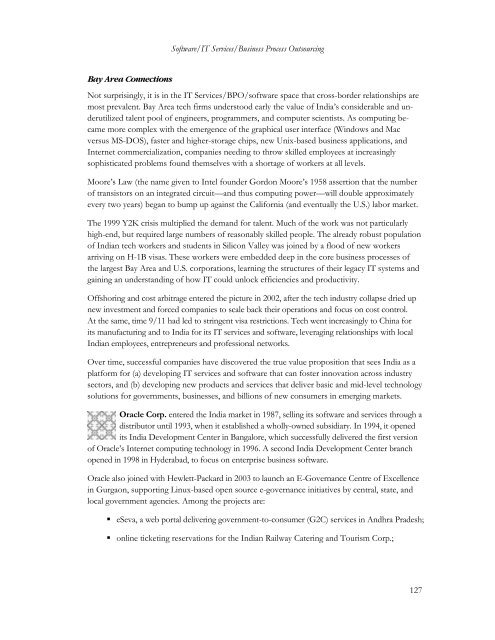PDF: 2962 pages, 5.2 MB - Bay Area Council Economic Institute
PDF: 2962 pages, 5.2 MB - Bay Area Council Economic Institute
PDF: 2962 pages, 5.2 MB - Bay Area Council Economic Institute
Create successful ePaper yourself
Turn your PDF publications into a flip-book with our unique Google optimized e-Paper software.
Software/IT Services/Business Process Outsourcing<br />
<strong>Bay</strong> <strong>Area</strong> Connections<br />
Not surprisingly, it is in the IT Services/BPO/software space that cross-border relationships are<br />
most prevalent. <strong>Bay</strong> <strong>Area</strong> tech firms understood early the value of India’s considerable and underutilized<br />
talent pool of engineers, programmers, and computer scientists. As computing became<br />
more complex with the emergence of the graphical user interface (Windows and Mac<br />
versus MS-DOS), faster and higher-storage chips, new Unix-based business applications, and<br />
Internet commercialization, companies needing to throw skilled employees at increasingly<br />
sophisticated problems found themselves with a shortage of workers at all levels.<br />
Moore’s Law (the name given to Intel founder Gordon Moore’s 1958 assertion that the number<br />
of transistors on an integrated circuit—and thus computing power—will double approximately<br />
every two years) began to bump up against the California (and eventually the U.S.) labor market.<br />
The 1999 Y2K crisis multiplied the demand for talent. Much of the work was not particularly<br />
high-end, but required large numbers of reasonably skilled people. The already robust population<br />
of Indian tech workers and students in Silicon Valley was joined by a flood of new workers<br />
arriving on H-1B visas. These workers were embedded deep in the core business processes of<br />
the largest <strong>Bay</strong> <strong>Area</strong> and U.S. corporations, learning the structures of their legacy IT systems and<br />
gaining an understanding of how IT could unlock efficiencies and productivity.<br />
Offshoring and cost arbitrage entered the picture in 2002, after the tech industry collapse dried up<br />
new investment and forced companies to scale back their operations and focus on cost control.<br />
At the same, time 9/11 had led to stringent visa restrictions. Tech went increasingly to China for<br />
its manufacturing and to India for its IT services and software, leveraging relationships with local<br />
Indian employees, entrepreneurs and professional networks.<br />
Over time, successful companies have discovered the true value proposition that sees India as a<br />
platform for (a) developing IT services and software that can foster innovation across industry<br />
sectors, and (b) developing new products and services that deliver basic and mid-level technology<br />
solutions for governments, businesses, and billions of new consumers in emerging markets.<br />
Oracle Corp. entered the India market in 1987, selling its software and services through a<br />
distributor until 1993, when it established a wholly-owned subsidiary. In 1994, it opened<br />
its India Development Center in Bangalore, which successfully delivered the first version<br />
of Oracle’s Internet computing technology in 1996. A second India Development Center branch<br />
opened in 1998 in Hyderabad, to focus on enterprise business software.<br />
Oracle also joined with Hewlett-Packard in 2003 to launch an E-Governance Centre of Excellence<br />
in Gurgaon, supporting Linux-based open source e-governance initiatives by central, state, and<br />
local government agencies. Among the projects are:<br />
• eSeva, a web portal delivering government-to-consumer (G2C) services in Andhra Pradesh;<br />
• online ticketing reservations for the Indian Railway Catering and Tourism Corp.;<br />
127








